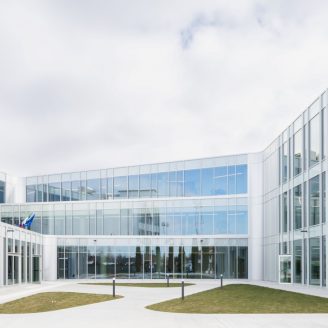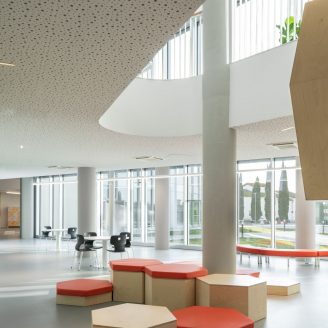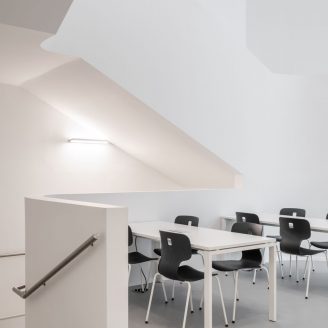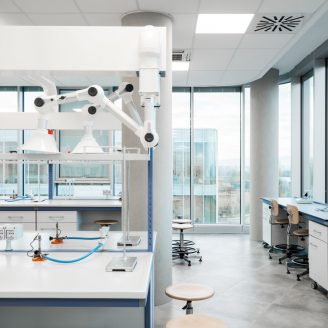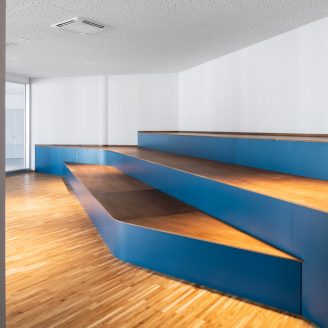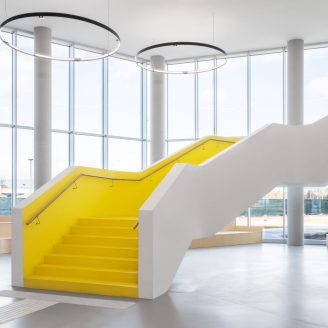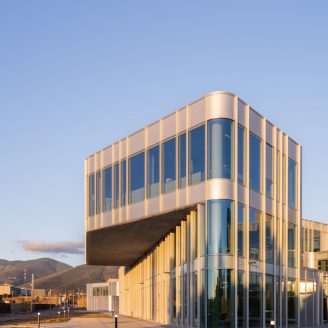Situated in a Florentine plain former agricultural context, the new Scientific “Anna Maria Enriques Agnoletti” High School in Sesto Fiorentino has been conceived by architectural studio Settanta7 as “a contemporary school, a privileged place for knowledge transmission, a civic centre and a point of reference for the community”.
The attractive and welcoming architecture is characterized by transparency and sinuosity which create a symbiotic relationship between the learning spaces and the new urbanization context; the building develops in one single elongated volume, made up of three blocks, two with a teaching/educational function and one dedicated to the gym.
The solidity of the blocks is interrupted by demi-courts which open up towards the scenery and are sloped so as to recall the directors of the country church present on the lot; the orientation of these pits also guarantees a perfect lighting of the learning spaces.
The building is developed on three floors above ground around the south court and on two around the north court. The rotation of the volumes has generated some terraces with a green covering that recalling the farming landscape reduces the carbon footprint of the new construction, as well as representing an ulterior educational space for students.
The school is designed to accommodate 900 students in 35 classrooms and 5 labs.
The ground floor of the school constitutes a space which is open to the local community. It’s divided into an auditorium, a coffee house and a library, as well as offices and labs: thanks to these activities the school will fully become a Civic Centre.
Using European community schools as a reference, the interiors have been designed inspired by creativity, entrepreneurship and student-teacher cooperation; the fluid and flexible distributive spaces encourage informal relationships and innovative educational approach. The spaces dedicated to “frontal teaching” are mainly housed on the east front, achieving greater lighting performance and internal comfort control.
Environmental considerations characterize the whole project. With its reinforced concrete structure, the building displays important energy saving technological systems: a 140 KWp photovoltaic system, a mechanically controlled ventilation system in all areas, an insulated enclosure and a solar input reduction system through screenline. The outdoor area foresees columns for green electronic vehicles and bicycle stands in protected areas.
Because of the surrounding artifacts, different characters have been chosen for the different fronts. On the western front a continuous facade, with a higher percentage of glass areas compared to opaque portions, as a sign of openness and welcome towards the user and the community; a configuration that poses itself in relation to the cycle path, to traffic and pedestrian mobility and to the nearby green area. labs, with their rigorous and functional character, are towards the East and this has determined an inversion in the transparent/opaque proportion. The labs are located on the faceted fronts of the courts.
Ample emphasis has also been given to the design of connective spaces; which are not only used for the movement of students but also for organizing complementary educational activities. The diffuse library, individual reading spaces and for group discussions, free time, meetings and tutoring were born this way, within the connectedness, as satellites that punctuate and enhance communal spaces.
The two main stairs are in fact the heart of the interior’s project: characterized by a double height, they represent the places of vertical connection, where it’s possible for students to build relationships and grow beyond the classroom. A CONI certified gym and a flexible auditorium complete the school’s equipment.
Finally, the entrance system is designed for the use of collective spaces even outside the school, in the multifunctional prospective of serving not only the school but also Sesto’s community.


